A good paint job will define a car. Some paint jobs, like the airbrush overload of the seventies, define an entire generation of car culture. If you have a project car, you know that eventually you will have to give it that final touch. You are going to need to prime, paint and shine. You’re going to need a paint gun.
Spraying paint at something is not a complicated process. After all, a can of spray paint is an all-in-one paint gun and paint container, and it costs a few dollars to grab a rattle can. So, it can’t be that hard to lay down some paint. With that in mind, It seems so crazy to know that there are thousands of paint guns on the market, each offering a special take on this simple process. How do you choose the one for you, and what exactly do you need?
- A Short Primer on Buying a Paint Gun
- Top 10 Paint Guns for Cars 2026
- 1. Best Overall Painting System: Fuji Semi-Pro 2 HVLP System
- 2. Best Budget Paint System: Wagner Spraytech HVLP Control Spray
- 3. Most Convenient HVLP Sprayer: 3M Accuspray Paint Spray Gun Kit
- 4. Best Premium HVLP Sprayer: DeVilbiss Finishline 4
- 5. Best Paint System for Large Projects: Fuji Mini-Mite 4 Platinum
- 6. Best HVLP Set for Any Project: TCP Global HVLP Set
- 7. Best All-in-One Sprayer: HomeRight Power Painter Super Finish Max
- 8. Best Inexpensive HVLP Sprayer: Campbell Hausfeld HVLP Gun
- 9. Best Pressure Pot System: TCP Global Pressure Tank With Spray Gun
- 10. Best Spray Gun for Thick Materials: TCP Global Air Undercoating Gun
- The Complete Guide to Paint Guns
- The Final Word on Paint Guns
A Short Primer on Buying a Paint Gun
First, read this quick primer. We’ll lay out the quick facts so you can get into the process fast and delve right into choosing. After our recommendations, there will be a much more in-depth guide at the bottom here.
HVLP
The first thing to know is that there are different types of spray guns. You can dive into it in more detail down here, but the most common type is called an HVLP sprayer.
HVLP stands for High Volume, Low Pressure. That means it can spray a lot of paint, and you don’t need tornado force winds to do it. They work best with thin to medium viscosity material. Your standard auto paints and clear coats fit nicely into that category. They also offer the best compromise between how fast you can paint something and how much overspray you have to worry about.
How Is the Paint Fed
Paint guns have a few different ways to actually get the paint into the gun.
A siphon feed, or conventional, spray gun has a cup underneath it. There’s a tube going into the container that sucks up the material and injects it into the air. Siphon feed guns are the easiest to use. They are also crucial for spraying some specialized materials like metal flecked paint.
A gravity feed gun has a cup on top, and it uses gravity to push the material into the gun. The gravity assisting makes the gun more efficient. That efficiency contributes to better atomization, a smoother finish, and less wasted material.
A pressure feed gun uses a pressurized container or a pump to push the paint up into the gun. It doesn’t need to siphon or rely on gravity. That means you can spray upside down, which can be really handy in tight spots. The downside is that it is much harder to clean because of the extra hoses and complications of the pressurized canister.
The Source of Air
HVLP guns are all powered by air. The air flows through, at low pressure, and mixes with the paint to form the spray. The most common sources of air are turbines or air compressors. You can read our guide below if you want to compare them.
The important thing is to make sure your air source meets the requirements for the gun you buy. Pressure, measured in PSI, and volume, measured in CFM, are the two most important numbers.
Some guns have a turbine or air compressor already attached, like the HomeRight HVLP in the recommendations. Others come with their own dedicated air source, like the Wagner Spraytech. Most dedicated HVLP guns, however, will require you to provide your own air source.
Quality
The quality of the gun makes a big difference in three main areas.
How Easy They Are to Clean
Sprayers have to be cleaned after every use. Dried material inside the gun turns it into a fancy paperweight. The easier they are to clean, the easier it’ll be to avoid that fate.
How Long They Will Last
Plastic parts, as well as cheaper metals, will wear out with a lot of use. If you plan on spraying a few projects a year, you’ll be okay with a gun that isn’t as robust as others. If you plan to lay down a few hundred gallons a year, you would be better off spending the money for a gun with better quality construction.
The Consistency of Spray
In order to get the best paint job possible you need a gun that is precise. High-quality guns will have better machining and accuracy. That gives them the ability to lay down a more consistent coat and a better finish over cheaper guns.
Type of Job
There are lots of different paints and finishes that can be applied to a car. It is essential to make sure the gun you choose can spray the material you want to use. That doesn’t just include the size of the gun. A bigger gun will generally be able to spray more material, but it also includes smaller considerations like:
Nozzle/Tip Size
The size of the hole the material is sprayed out of dictates how thick the material you are spraying can be. Check out this chart at the bottom of the page to make sure you can use the material you need.
Container Size
If you are just doing touch up and airbrushing, you don’t need a large material reservoir. If you are painting a large area, though, having to refill often is annoying.
Hose Length
If you are supplying your own air compressor and hose, you don’t have to worry about it. If you are buying a unit with its own hose, make sure it’s long enough to do the job.
Once you have the basics in mind, it can still be tough to choose the right one because of the sheer number of options. Don’t worry, we have your back. Here are the 10 spray guns we would recommend.
| Product | Type of Gun | Container Size | Tip Size | Air Compressor/Turbine | Rating |
|---|---|---|---|---|---|
| Fuji Semi-Pro 2 HVLP System | Gravity Feed HVLP, convertible to conventional feed. | 12oz | 1.3mm installed, Interchangeable | Two-stage turbine included with 25ft hose | 5 |
| Wagner Spraytech HVLP Control Spray | Siphon Feed HVLP | 32oz and 48oz | Adjustable | Portable turbine and 20ft hose | 5 |
| 3M Accuspray Paint Spray Gun Kit | Gravity Feed HVLP | 32oz | Disposable 1.2mm, 1.3mm, 1.4mm, and 1.8mm, with a 2.0mm available for purchase | 10 CFM at 25 PSI compressor required, no hose | 5 |
| DeVilbiss Finishline 4 | Gravity Feed HVLP | 32oz | 1.3mm, 1.5mm, 1.8mm | 13 CFM at 25 PSI compressor required, no hose | 4.5 |
| Fuji Mini-Mite 4 Platinum | Siphon Feed HVLP | 32oz | 1.3mm, interchangeable | 4-stage turbine with 25ft hose | 4.5 |
| TCP Global HVLP Set | Gravity Feed HVLP x3 | 32oz x2, 5oz x1 | 1.8mm x1, 1.4mm x1, 1mm x1 | 7 CFM at 30 PSI air compressor required, no hose | 4.5 |
| HomeRight Power Painter Super Finish Max | Siphon Feed HVLP | 40oz | 4mm, 2mm, 1.5mm | Built into the gun | 4 |
| Campbell Hausfeld HVLP Gun | Gravity Feed HVLP | 20oz | 1.4mm | 4.5 CFM at 40 PSI air compressor required, no hose | 4 |
| TCP Global Pressure Tank With Spray Gun | Pressure Feed HVLP | 2.5 gallons | 1.5mm | 8 CFM at 50 PSI air compressor required, 10ft hose fixed to the pot | 4 |
| TCP Global Air Undercoating Gun | Siphon Feed | 25oz | n/a | 9 CFM at 80 PSI air compressor required | 3.5 |
Top 10 Paint Guns for Cars 2026
1. Best Overall Painting System: Fuji Semi-Pro 2 HVLP System
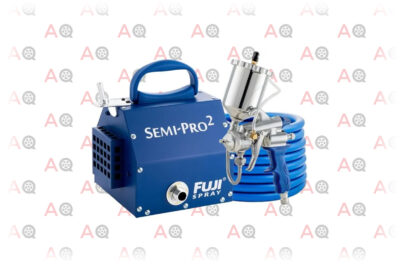
Editor’s Rating:
Specifications
- Type of Gun: Gravity Feed HVLP, convertible to conventional feed.
- Container Size: 12oz
- Tip Size: 1.3mm installed, Interchangeable
- Air Compressor/Turbine: Two-stage turbine included with 25ft hose
Who Is This Gun For?
The Fuji Semi-Pro 2 is perfect for someone with nothing but wants a good quality system for tackling a lot of small to medium projects. It comes with everything you need to get started and will grow with you over time.
First off, the gun is good quality. The metal parts will last a long time, and it features Fuji’s modular system. That means you can convert the gun to perform different tasks. If you want a high volume siphon cup, they sell one for it. If you want to turn it into a very fine airbrush-like gun, they sell parts to do that too.
The only issue is that you won’t want to do any big projects with this little unit. Even though you can buy and install a bigger reservoir, the included 12oz cup will have you spending more time mixing paint than spraying. The compressor isn’t big enough to lay down a large volume either. If you need to do bigger jobs, check out the Semi-Pro 2’s bigger brother on the list here. Just be prepared to spend a lot more.
Is It Easy to Use?
All HVLP guns have a learning curve, but the Semi-Pro 2 makes it easy to overcome by providing you with everything in one convenient package. You won’t have to worry about dialing in an air compressor or finding the right hose. At 25ft, the hose isn’t going to hold you back. You won’t have those awkward moments when you walk too far around a project and come unplugged.
The gun has plenty of adjustments too, so you can dial in the pattern you need. It also includes a gravity-fed no-bleed cup that looks a little intimidating at first, but it makes for a more intuitive feel to the trigger. Perhaps most importantly, it is easy to keep clean. The metal gun breaks down quickly, and you can scrub away without fear.
Pros
- Parts are high quality
- Air supply produces good power for the price
- Modular gun is a very versatile platform
- Gun is very easy to clean
Cons
- Small reservoir means it's not suited for large projects
- Extra tip sizes and gun parts have to purchased separately and are expensive
2. Best Budget Paint System: Wagner Spraytech HVLP Control Spray

Editor’s Rating:
Specifications
- Type of Gun: Siphon Feed HVLP
- Container Size: 32oz and 48oz
- Tip Size: Adjustable
- Air Compressor/Turbine: Portable turbine and 20ft hose
Who Is This Gun For?
The Wagner Spraytech Complete is for the DIY painter on a budget. You get everything you need to start spraying at a very reasonable price. The turbine isn’t super powerful, but it’s enough for medium-sized jobs. Mostly, the straightforward design means even first time painters will quickly get the hang of it.
The biggest drawback to the Wagner Spraytech is the plastic. The entire thing is made of plastic, and plastic has a bad habit of wearing out over time. That should be fine if you only plan on spraying a few projects here and there. It’s also okay if you are looking for a first step into a new hobby. It doesn’t make sense to buy a high-quality, expensive machine like the Fuji on this list if you don’t even know that you like painting, or only expect to infrequently use it.
You won’t find much to complain about other than the quality, though. The Wagner can handle bigger jobs, boasting some of the largest reservoirs on this list. It also has a large tip that can handle a variety of materials. Storing the unit is also really easy; the portable turbine comes with a holder for the gun. That probably isn’t very high on the priority list, but it is pretty convenient when you have it.
Is It Easy to Use?
Everything about the Wagner makes it easy to use. The gun is lightweight and has very few parts, so it’s easy to work with. The hose is easy to connect and stretches 20ft. Since the tip is not interchangeable, you don’t have to worry about losing pieces. Just adjust the size with a dial on the side, and you are good to go. The only thing on the list easier to use is the HomeRight, but it doesn’t have nearly the power that the included Wagner turbine has.
It can be a little frustrating to keep clean, though. You’ll want to make sure to run cleaner through the gun until it runs clear to make sure nothing dries inside it. It’s a very inexpensive gun, but that doesn’t mean you want to replace it after one use.
Pros
- Includes air supply
- It's straightforward to set up and use
- Very inexpensive for a complete setup
Cons
- Quality is low
- Guns are not very adjustable
3. Most Convenient HVLP Sprayer: 3M Accuspray Paint Spray Gun Kit
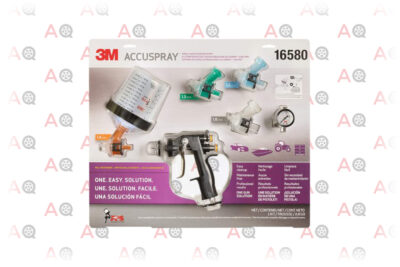
Editor’s Rating:
Specifications
- Type of Gun: Gravity Feed HVLP
- Container Size: 32oz
- Tip Size: Disposable 1.2mm, 1.3mm, 1.4mm, and 1.8mm, with a 2.0mm available for purchase
- Air Compressor/Turbine: 10 CFM at 25 PSI compressor required, no hose
Who Is This Gun For?
The 3M Accuspray is a really unique gun, and it has one great feature that makes it worth the high price: the plastic tips are easy to remove and change out. If they get too dirty, you just throw them away and grab a new one out of the box. Every time you start a new project it’s like starting with a new gun.
The added bonus to having easy to replace tips is that you can swap in different sizes. If you start spraying a new material and it’s clogging up a bit, swap to a bigger tip. The time you save not having to re-mix paint or fiddle with dirty tips is worth the extra money it costs to get set up with the Accuspray.
Of course, there are a few downsides. You’ll need to supply your own air, so make sure you budget for that. Second, it’s never going to give you the quality you’ll get from something like the Finishline on this list because of the interchangeable plastic tips. It will do 99% of jobs, but if you need that upper 1% of quality, then you’ll need to spend the extra money on the high precision gun.
Is It Easy to Use?
It’s okay. You will need to source your own compressor and hoses, so that can be a hassle. However, you won’t have to worry very much about cleaning. Even if you forget and paint dries inside the gun, you can just pop the plastic parts off, and then toss the rest of it in the cleaner.
Even the cup has a removable liner, so you don’t have to clean out the reservoir after every use. You just throw it away. If you never want to waste time cleaning or messing with a gun that is getting a little worn out, here you go. If a part starts acting up, just toss it and grab a new one. It’s hard to oversell how convenient that is. The most frustrating thing in the entire world of spraying paint is a clogged tip.
Pros
- Disposable liners and tips make cleanup very easy
- Disposable tips are available in a range of sizes
- One gun can be used for a lot of different projects
Cons
- Consumables can become expensive over time
- No included air supply
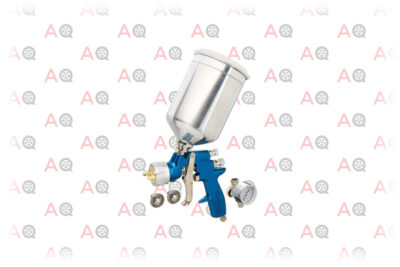
Editor’s Rating:
Specifications
- Type of Gun: Gravity Feed HVLP
- Container Size: 32oz
- Tip Size: 1.3mm, 1.5mm, 1.8mm
- Air Compressor/Turbine: 13 CFM at 25 PSI compressor required, no hose
Who Is This Gun For?
The Finishline 4 is just an HVLP sprayer, and it’s an expensive one at that. There are better options if you are just starting out. There are options like the CH spray gun further down that can use a smaller compressor and cost less.
However, if you have the compressor already and are comfortable with spraying, the Devilbiss Finishline won’t let you down. Devilbiss is a big player in the pro world and they are serious about their craft. The anodized frame and all-metal construction means it will last forever. The fit and finish means you’ll never walk around dripping. The buttery smooth double stage trigger feels excellent and won’t fatigue your hand even if you spend all year spraying.
You’ll also be laying down beautiful coats with low overspray. The high-efficiency gravity feed design will complement both years of practice and neophytes picking up a sprayer for the first time. It included extra tips and tons of adjustment dials. You can tune it for anything you want to spray through it.
Is It Easy to Use?
Let’s just get this out there, the answer is no. Higher-end guns just need more fiddling with. The adjustments are plentiful but very sensitive. That’s great if you want to dial in the perfect pattern, but can be frustrating as heck if you are new to spraying. Since it does not include an air supply, it’s up to you to source a compressor and hose. Having to buy those things adds another layer of complication to the process.
The only good news is that since it is made from corrosion-resistant metal, it’s easy to clean once you do take it apart. Even if you let the material dry on the inside of the gun, not all is lost. Shame on you for being lazy, but you can soak every piece in thinner and scrub it clean without fear.
Pros
- High-quality parts
- Very easy to clean
- Multiple tips included
- Highly adjustable gun
Cons
- Expensive for a single gun
- No air source included
5. Best Paint System for Large Projects: Fuji Mini-Mite 4 Platinum
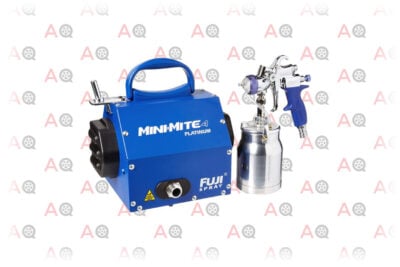
Editor’s Rating:
Specifications
- Type of Gun: Siphon Feed HVLP
- Container Size: 32oz
- Tip Size: 1.3mm, interchangeable
- Air Compressor/Turbine: 4-stage turbine with 25ft hose
Who Is This Gun For?
This system is for the hardcore DIY crowd, or even as a backup for a professional shop. The Fuji Mini-Mite 4 Platinum is what happens if the Semi-Pro 2 from earlier on this list hits the gym and learns to lift. It has a 4 stage turbine that can oxidize even thick materials, and can lay down an ultra-smooth finish that will make your car worth telling people to stop breathing on.
The kit also comes with the larger sprayer that is better for bigger jobs. It sports a 32oz siphon cup attached to a 25ft hose. That way, you can do laps around your project without running out of room or paint. The gun is super high quality, too, even rivaling the more expensive standalone sprayers on this list like the Finishline.
All of that function comes for a price, though. The Mini-Mite is easily the most expensive thing we are willing to recommend here. It’s worth it if you plan on painting the next Concours winner.
Is It Easy to Use?
It is. It may be even easier to use than its smaller cousin. With a larger reservoir and a more traditional gun, you’ll spend more time spraying and less time fiddling setting it up.
Like other systems that include their own air source, the biggest advantage is that there’s no guessing or giant air compressors. Just pull it out of the box and go. The T-Series gun that the Mity-Mite comes with will be a little harder to clean than the M-Series. Still, it features the same no-bleed design that is standard on professional setups.
All of that combines to form one of the most intuitive and fast systems on this list. The extra power means you don’t have to be as accurate with viscosity, and the one-stage trigger means you just point and spray. Honestly, for the price, you’d hope that was the case – and thankfully it is.
Pros
- Made from high-quality materials
- Very easy to use and clean
- Portable turbine produces a good amount of power
- Large capacity gun can handle large projects
Cons
- High initial investment price
- Extra tip sizes and gun parts have to purchased separately and are expensive
6. Best HVLP Set for Any Project: TCP Global HVLP Set
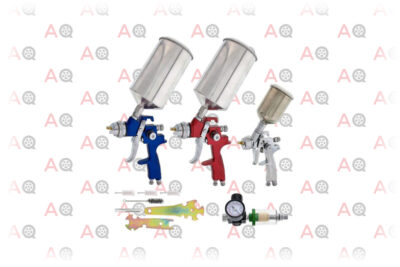
Editor’s Rating:
Specifications
- Type of Gun: Gravity Feed HVLP x3
- Container Size: 32oz x2, 5oz x1
- Tip Size: 1.8mm x1, 1.4mm x1, 1mm x1
- Air Compressor/Turbine: 7 CFM at 30 PSI air compressor required, no hose
Who Is This Gun For?
The TCP HVLP set includes three different HVLP guns setting you up to tackle anything. The 1.8mm tipped gun can handle primers and other higher viscosity work. The 1.4mm tipped gun is perfect for lightweight paints and finishes. Finally, the smaller 1mm tipped gun is ideal for touch up and details.
If you already have an air compressor, then you can buy this kit and dive headfirst into the world of paint and finish. You won’t be breaking the bank to do it either. Only the Campbell Hausfeld sprayer is less expensive per gun. You get a metal cup instead of a plastic cup with the TCP, though, and there’s three of them.
You might be let down if you are a bit more serious about your finishes. Yes, the kit does include everything you need to do it all. It just won’t be at the quality of the higher priced guns like the Finishline we recommended. The atomization of the material just won’t be quite as good, and the parts will be a little bit more likely corrode. If you aren’t that hardcore, then this set is perfect.
Is It Easy to Use?
The TCP set is not as easy as others on the list. Three times the number of options means three times the amount of parts to adjust and keep clean. There is something to be said about having those options, though. If one gun is not working out for you, swap it for another and see if it works better.
The guns themselves are easy to keep clean, which is always nice. They are all metal and break down easily. However, you might have to tighten screws and fiddle with the knobs more often. Loose tolerances are an issue you will find on any budget spray gun.
Pros
- The 3 gun set covers just about every project
- Easy to clean and maintain
- Convenient dials make adjusting the pattern very easy
Cons
- Prone to corrosion if not maintained
- No included air supply
7. Best All-in-One Sprayer: HomeRight Power Painter Super Finish Max
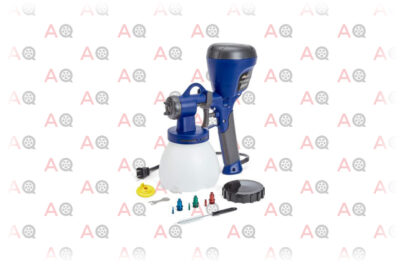
Editor’s Rating:
Specifications
- Type of Gun: Siphon Feed HVLP
- Container Size: 40oz
- Tip Size: 4mm, 2mm, 1.5mm
- Air Compressor/Turbine: Built into the gun
Who Is This Gun For?
If you are looking for a sprayer that you can just pull out of the box, fill with paint and start painting, here it is. The HomeRight Finish Max is a complete system contained in the gun. We really do live in the future, right?
There’s a lot of downsides to that, though. First off, like the Wagner on this list, it’s made of plastic through and through. Not an ideal piece of equipment if you plan on using it hundreds of times. Unlike the Wagner, the gun is heavy. It has a large reservoir and a turbine attached to it. That turbine isn’t powerful either. It’s compact and will never push the air volume that a separate system will. You really have to value the convenience and simplicity to give this thing a go.
It does have some really cool features you won’t find on other guns in its class. It has interchangeable metal tips that range from the smaller fine finish tips to the large tips that can spray unthinned latex paint. Coupled with the adjustable widths and pattern selectors, you can paint your shed one day and paint your car the next.
Is It Easy to Use?
Nothing on this list is easier. Fill it with paint, plug it in, and point it at what you plan on painting. Cleanup is easy enough, and there aren’t any parts to lose or break. There’s not much to say about it. Grab one and head down the page to here and learn some tips on spraying.
Pros
- All-in-one design means no hoses or external parts
- Can spray a wide variety of materials
- Very simple to use
Cons
- Plastic parts are prone to wearing out quickly
- Air supply is not powerful enough for good atomization and fast spraying
8. Best Inexpensive HVLP Sprayer: Campbell Hausfeld HVLP Gun
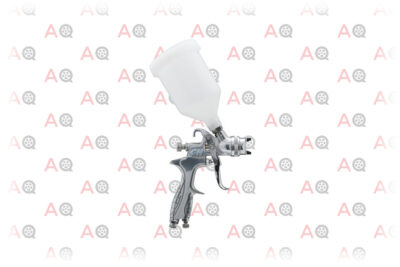
Editor’s Rating:
Specifications
- Type of Gun: Gravity Feed HVLP
- Container Size: 20oz
- Tip Size: 1.4mm
- Air Compressor/Turbine: 4.5 CFM at 40 PSI air compressor required, no hose
Who Is This Gun For?
The Campbell Hausfeld HVLP gun is the perfect first gun. If you want to get serious about laying down the finish and are willing to shop around for an air compressor, then you can pick up this gun for the price of a good meal and start your journey. You don’t even need a very powerful compressor since this HVLP gun is happy with 5CFM.
The size makes it perfect for medium projects. The cup isn’t as big as you will want for larger projects, and the tip size doesn’t lend itself well to detail work. If you really need those extra options, then fork over a few more dollars for the TCP set mentioned on this list.
What you won’t get is professional quality. The cup is plastic, and the adjustment dials are sloppy. You’ll be fighting overspray, and you might not get the atomization you want for really smooth paint. You could buy about ten of these for the price of the much higher quality Accuspray on this list, though. You won’t feel bad using and absuing these guns to learn your craft.
Is It Easy to Use?
The CH HVLP is about middle of the road when it comes to ease of use. It’s not bad, but you will need to source your own air supply and fiddle with it. It doesn’t need a powerful air supply to work well, and that does make it easier to set up in the average shop. Even if you don’t already have a compressor, Campbell Hausfeld is well known for making their own air compressors which are also available at a budget price.
It is all metal. That sets it apart from other budget options. You’ll be able to take it apart and clean it without issue. The only thing that can be annoying is the plastic cup. Plastic will get stained and need replacing long before the rest of the gun.
Pros
- Easy to clean and maintain
- Inexpensive
- Can run off a small air compressor
Cons
- No included air supply
- Quality is inconsistent
9. Best Pressure Pot System: TCP Global Pressure Tank With Spray Gun
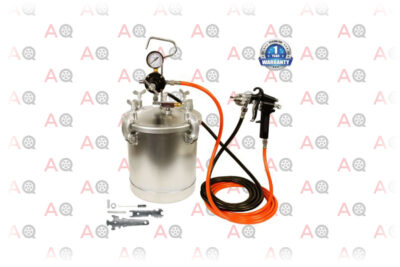
Editor’s Rating:
Specifications
- Type of Gun: Pressure Feed HVLP
- Container Size: 2.5 gallons
- Tip Size: 1.5mm
- Air Compressor/Turbine: 8 CFM at 50 PSI air compressor required, 10ft hose fixed to the pot
Who Is This Gun For?
Are you about to paint an entire bus? Then look no further. The TCP Pressure Pot can hold 2.5 gallons of material. That’s nearly five times the size of the next largest reservoir on the list.
This is the only pressurized system on this list. You can learn more about it down the page here. In short, it uses air to pressurize the reservoir and force the material into the gun. That gives you the most control over the spray that you can get and allows you to spray in any position.
Mostly this unit is all about speed and volume. You can spray unthinned material and spray a huge amount of it in a short amount of time. Even the powerful compressor on the Fuji Mini-Mite on this list pales compared to the size of the job that a pressure pot can handle.
You will be sacrificing a lot of convenience for that volume, though. You’ll need a good size air compressor to charge the pot. You’ll also be tethered to the pot with a 10ft hose, so get your biceps curls in now. You’ll need them to tote 2.5 gallons of material around with you as you work through the project.
Is It Easy to Use?
Nope. Not even close. It’s the hardest to use tool on this list by far.
Let’s start with the fact that you will be spending a lot of time disassembling and cleaning this unit. The hose can get clogged with material, the seals can rot and corrode, the gun is extra sensitive because of the higher pressure, etc.
You can get it into tight areas and spray upside down, though. That can make the actual spraying easier since you don’t have to worry about spilling or starving the gun. That’s the reward for how much work it takes to set up. Yet it’s hard to say that it’s worth it if you don’t need it.
Pros
- Can hold a lot of material
- Pressure fed system can spray in any position
- Low price for a pressurized system
Cons
- Needs a robust air compressor that is not included
- Hard to clean and maintain
10. Best Spray Gun for Thick Materials: TCP Global Air Undercoating Gun

Editor’s Rating:
Specifications
- Type of Gun: Siphon Feed
- Container Size: 25oz
- Tip Size: n/a
- Air Compressor/Turbine: 9 CFM at 80 PSI air compressor required
Who Is This Gun For?
This gun is on the list for those who need to spray thick materials like bed liners or rubberized coatings. The TCP Global Air Gun is a dead-simple siphon gun that can spray anything that fits through the straw in the reservoir. Being simple is also the reason it will probably last forever: there’s nothing to wear out.
The drawback is that you don’t get any kind of fine control. You won’t be airbrushing ghost flames with this paint gun. Since it’s for things like bed liner and single component undercoatings, that’s probably not an issue. Just make sure you tape off anything that you don’t want sprayed.
Is It Easy to Use?
Since it has no tip, no regulator, and no flow control, there is nothing to fiddle with. That does make it very easy to use. Fill the cup with material and connect it to an air hose, and you are good to go.
The gun is easy to clean. There’s only a couple parts, and they are metal. Simply scrub it down with solvent and call it good. The only thing that stops this from being the most accessible device on the list is the need for an air compressor.
Pros
- Can spray nearly any liquid
- Inexpensive
- Easy to disassemble and clean
Cons
- Needs high pressure to work well
- No gun adjustability
The Complete Guide to Paint Guns
If you’ve read the quick start guide and seen our recommendations, but are still hungry for more knowledge, then this section is for you. We’ve also included some tips for laying down the perfect finish at the end. Just be aware that there is no substitute for practice. It’s totally ok to paint a few old boxes before attempting a mirror glaze.
Types of Paint Gun
There are four main types of paint gun:
HVLP – High Volume Low Pressure
We’ve been talking about these things for most of this article, but we can reiterate. An HVLP gun uses low air pressure to mix with a high volume of material and create an even, well-mixed spray. They are less expensive, more common, and easier to use than other styles. The downside to HVLP is that they can’t spray out of position. Check out almost anything on the recommendation list, like the Fuji Semi-Pro, to see an example.
HVLP guns either pick up the paint from a siphon cup underneath the gun, or a gravity cup above the gun. A gravity feed gun is more efficient than a siphon gun since gravity helps out with the process. A siphon feed gun is a bit simpler. They can be used at a greater number of angles than a gravity feed gun since there is no chance that material can spill out of a cup attached to the bottom. They need more air pressure, though, and can be harder to clean.
LVLP – Low Volume Low Pressure
Like HVLP, an LVLP gun uses low-pressure air to atomize material and create an even spray. Unlike HVLP, an LVLP gun does not use a high volume of material. They are more efficient and much more controllable than their high volume counterparts. However, when compared to HVLP, they are much slower. They require lower pressure and spray less material. That means you’ll be spending a lot more time holding down the trigger to cover the same area.
Like HVLP, an LVLP gun can be gravity feed or siphon feed, although they are much more commonly siphon feed.
Air Pressure Assisted
Pressure-assisted guns use a separate pressurized container to feed material into the gun. They are best for thicker materials and for spraying a huge area. With the extra pressure assistance, they can spray out a lot more material than their HVLP and LVLP counterparts. They are harder to use and clean, and like LVLP they have been mainly replaced by HVLP in the hobby and semi-pro realms. There is still one on the recommended list, though, the TCP Global Pressure Pot.
Airless
Airless paint sprayers are very common for painting houses since they can pump very thick paint and a very high volume. Like the name implies, they don’t use any air. Instead, they use a pump that just pumps the material straight into the gun with a decent amount of pressure. You really sacrifice a lot of control with an airless gun. That’s why you rarely see someone using one to paint cars.
Tip Size
This is easy; the bigger the hole, the thicker the material can be sprayed. Just reference this list:
- 1mm or less: Very thin material like diluted lacquer
- 1mm-1.3mm: Thin material like clear coats and thinned paint
- 4mm-1.7mm: Basecoats, oil paints and thicker clear coats
- 8mm-2.2mm: Primers and heavier paints
- >2mm: Latex paints
Air Source
Your air source will dictate how much control you have over the spray pattern, the volume of material you can spray at one time, and how long you can spray without taking a break. Usually, your air source will come from one of two devices: a turbine or an air compressor.
Turbine
It’s easy to visualize a turbine as a small leaf blower since they work very similarly. Turbines are usually less expensive than an air compressor, but can’t generate the high pressures that a compressor can. They can run continuously and are much smaller than an air compressor, though. That makes them prime candidates for portable painters, painters with a small shop, or painters that want something quieter than a large compressor.
If a paint sprayer includes an air source, then it’s almost always a turbine. Like the Fuji Mini-Mite from the list, some can stand toe-to-toe with many air compressors in power. Others, like the inexpensive Wagner, are just barely enough to atomize the paint.
Air Compressor
An air compressor can fill a tank with compressed air and provide much higher pressure and volume than a turbine. That extra pressure can be used with guns that cover a large area or push thicker materials. It gives you the most amount of control over the materials and patterns. Professional shops that use professional guns like the Finishline on the list use large air compressors.
Compressors are loud, expensive, and take up a ton of space. Even more efficient HVLP guns like the Campbell Hausfeld on the list still needs a relatively high CFM to work well. If you have a compressor that can’t put out the volume, you’ll have to stop frequently and wait for it to charge. That’s an issue because every time you start and stop is a chance for puddles and unsightly build-up to form.
Tips for Spraying With Your Paint Gun
So you have an air source, a gun, and some paint. Now comes the hardest part. If you thought choosing the gun was tough, just wait until you start laying paint down. You’ll learn new curse words like “water contamination” and “orange peel.” If you want to see what those look like, click over to this troubleshooting site to see what horrors await you.
Don’t worry. Hundreds of thousands of people do it every week, and we have some tips to get you started.
Safety First
Wear a mask that can filter out fine particles. Paint is bad for your insides, trust us. If you prefer, trust the CDC. Even with a mask, it’s good to be in a well-ventilated area before you paint. Also, wear gloves when mixing things. If nothing else, it will prevent your hands from being a Pollock painting after the project.
There, safety rant over.
Thin Your Materials to the Proper Viscosity
There is no one size fits all answer to “how thin should my material be.” There are just too many variables: the type of material, the type of thinner, the tip on the gun, the weather, the amount of patience you have, etc. There are tools to measure viscosity, but they are expensive. Instead, here are a few pointers to get you on the right track.
Use a Notebook
Keep a notebook around your station and record your ratios. You’ll be able to reference it in the future and re-create ratios that worked well. Try to also note the temperature and humidity so you can make adjustments. Exact numbers don’t matter as much as noting that it was hot like Texas and humid like a Florida swamp. That way, you know to add a lot more thinner when it’s cold like an Alaskan winter.
Stir Your Sample Correctly
When you stir a sample, make a note of how much sticks to your stir stick. Then you can do a dip test. Just stick a stir stick into the medium and pull it out. The way it flows off the stir stick can tell you a lot about how thin the material is and whether you’re ready to spray.
Use the Right Thinner
This is really important if you care about how the final product will look. Water is great for thinning out water-based paint but will absolutely ruin any oil-based product. Some materials have their own special thinners and reducers. Generally, having a bottle of mineral spirits and acetone on hand will cover all your bases.
Google It
If you go to Google and type “the best way to thin X paint for an HVLP sprayer,” you will get tons of answers. That will give you an excellent place to start.
Keep the Gun Clean
Nothing is more important than cleanliness when spraying paint. The opening on a fine sprayer is less than the thickness of a tooth pick. A speck of dust can clog the tip and ruin your day. Unless you have removable, disposable tips like the Accuspray, you should focus on keeping the tip and needle clean. Take apart the gun and soak the pieces in thinner and wipe them down before and after every use.
Don’t Let the Material Dry Inside the Gun
Run thinner through the gun after you finish spraying until it comes out clean. Especially finishes that are meant to harden and protect the paint. If those set inside your spray gun, then you might as well have poured concrete down it because the result is the same.
Practice
No one got good at anything without practicing. What makes it more difficult is that every paint gun is different. Even two HVLP guns with similar specifications can behave differently. You’ll have to just practice with whatever gun you decide to buy. You can find the best techniques to practice on Youtube. It really helps to see what motions you’ll want to perform. This video by Tom Stringham is a bit dry but covers just about everything you’d want to know from set up to spray technique.
If you feel like keeping it simple then just make sure to practice keeping a consistent distance and angle to the surface. The more evenly you can keep the fan pattern on the work, the better your results will be.
The Final Word on Paint Guns
Nothing completes a car as much as a great paint job. When your car has a perfect cherry finish, you can join the exclusive club of people whose anxiety spikes at car shows when you see children running around with ice cream. However, a good shop will charge you at least three arms and one leg for that privilege. That’s a big ouch.
Doing it yourself can be terrifying and confusing. Don’t let it be. You’re happy to turn the wrench on every other part of your car, don’t let a little paint scare you off. Use this guide. Buy a great sprayer, practice a little, and let the reward of a well-done job wash over you.


